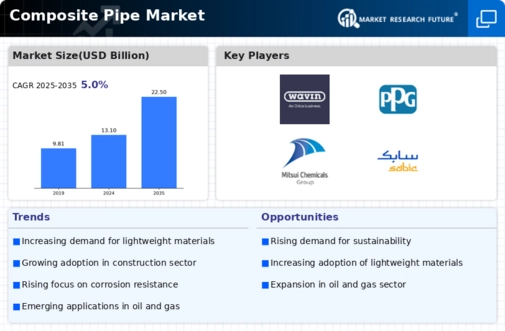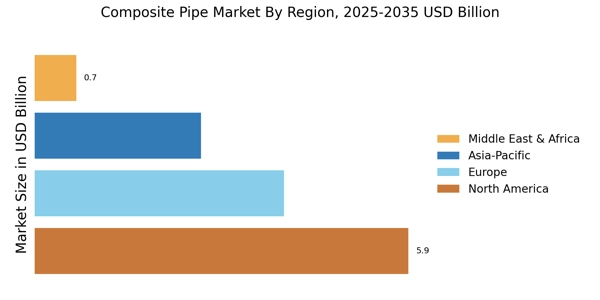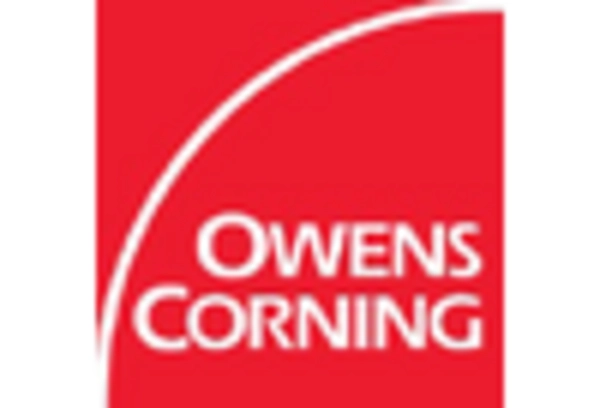Expansion of Oil and Gas Sector
The Composite Pipe Market is experiencing growth due to the expansion of the oil and gas sector, which is increasingly adopting composite piping solutions. The need for efficient and reliable transportation of hydrocarbons, especially in challenging environments, has led to a rising preference for composite pipes. These pipes offer advantages such as resistance to corrosion and lower weight, which are critical in offshore and remote applications. Recent estimates suggest that the oil and gas industry is set to invest heavily in infrastructure upgrades, further driving the demand for composite pipes. As exploration and production activities expand, particularly in emerging markets, the Composite Pipe Market is likely to benefit from this trend, as companies seek durable and efficient piping solutions to enhance operational efficiency.
Growing Environmental Regulations
The Composite Pipe Market is increasingly influenced by growing environmental regulations aimed at reducing pollution and promoting sustainability. Governments are implementing stricter guidelines regarding the materials used in construction and infrastructure projects, pushing industries to adopt eco-friendly alternatives. Composite pipes, which often utilize recyclable materials and have a lower environmental impact compared to traditional piping solutions, are well-positioned to meet these regulatory demands. The emphasis on sustainability is prompting manufacturers to innovate and develop composite materials that align with environmental standards. As industries strive to comply with these regulations, the demand for composite pipes is likely to rise, positioning the Composite Pipe Market as a key player in the transition towards more sustainable practices.
Rising Demand for Lightweight Materials
The Composite Pipe Market is experiencing a notable increase in demand for lightweight materials across various sectors. Industries such as construction, automotive, and aerospace are increasingly adopting composite pipes due to their superior strength-to-weight ratio. This shift is driven by the need for enhanced fuel efficiency and reduced transportation costs. For instance, composite pipes can weigh significantly less than traditional materials, which can lead to lower operational expenses. As a result, manufacturers are focusing on developing innovative composite materials that meet the rigorous standards of these industries. The growing emphasis on reducing carbon footprints further propels this trend, as lightweight materials contribute to lower emissions during transportation and installation. Consequently, the Composite Pipe Market is poised for substantial growth as more sectors recognize the advantages of lightweight composite solutions.
Increased Investment in Infrastructure Projects
The Composite Pipe Market is benefiting from increased investment in infrastructure projects worldwide. Governments and private entities are allocating substantial budgets for the development and maintenance of infrastructure, including water supply systems, sewage systems, and oil and gas pipelines. According to recent data, infrastructure spending is projected to reach trillions of dollars over the next decade, creating a robust demand for durable and efficient piping solutions. Composite pipes, known for their corrosion resistance and longevity, are becoming the preferred choice for these applications. This trend is particularly evident in regions where aging infrastructure necessitates urgent upgrades. As investments continue to flow into infrastructure development, the Composite Pipe Market is likely to see a corresponding rise in demand, driven by the need for reliable and sustainable piping solutions.
Technological Innovations in Composite Materials
The Composite Pipe Market is witnessing a surge in technological innovations that enhance the performance and applicability of composite materials. Advances in manufacturing processes, such as automated fiber placement and resin infusion techniques, are enabling the production of high-quality composite pipes with improved mechanical properties. These innovations not only increase the durability and lifespan of the pipes but also reduce production costs, making them more competitive against traditional materials. Furthermore, the integration of smart technologies, such as sensors embedded within composite pipes, allows for real-time monitoring of structural integrity and performance. This capability is particularly valuable in critical applications such as oil and gas transportation. As these technological advancements continue to evolve, the Composite Pipe Market is expected to expand, driven by the demand for high-performance and smart piping solutions.


















Leave a Comment